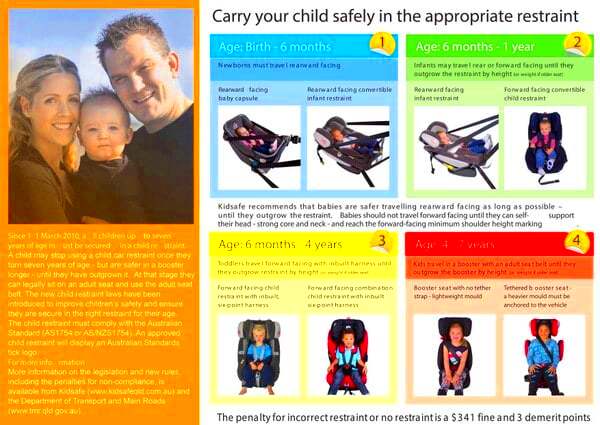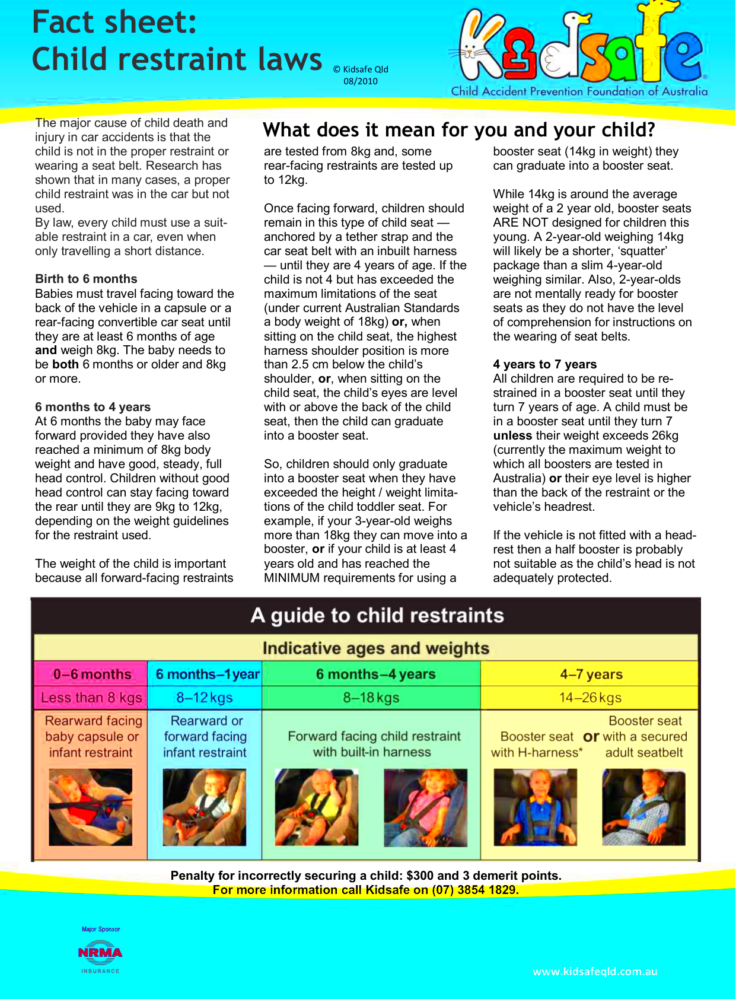Car Seat Laws in Queensland and Australian Safety Standards
Car seat laws are vital for ensuring the safety of children while traveling in vehicles. In Queensland, specific regulations dictate how and when to use car seats. These laws are designed to protect young passengers from potential harm during a crash. Understanding these laws is crucial for parents and caregivers to comply with regulations and keep children safe. In this section, we will explore the key aspects of car seat laws in Queensland and their importance for child safety on the road.
Overview of Australian Safety Standards

Australia has established stringent safety standards for car seats to ensure the utmost protection for children. These standards, set by the Australian Competition and Consumer Commission (ACCC), outline the following key points:
- AS/NZS 1754: This is the primary standard that all child car seats must meet. It includes safety requirements for design, performance, and testing.
- Restraint Types: The standards categorize restraints based on the child’s age, weight, and height, ensuring that the correct seat is used at the right stage of development.
- Regular Updates: The standards are regularly reviewed and updated to incorporate new safety technologies and research findings.
Car seats that meet these standards provide peace of mind to parents, knowing that their child is secured in a seat designed for maximum safety.
Types of Car Seats and Their Uses
Understanding the different types of car seats is crucial for selecting the right one for your child. Here’s a breakdown of the primary types:
| Type of Car Seat | Recommended Age/Weight | Key Features |
|---|---|---|
| Rear-Facing Seat | Newborn to 2 years (up to 12 kg) | Protects the head, neck, and spine; should be used until the child reaches the maximum height or weight limit. |
| Forward-Facing Seat | 2 to 7 years (up to 18 kg) | Secured with a harness; offers more room as the child grows but must be used until reaching height/weight limits. |
| Booster Seat | 4 to 8 years (between 14 kg and 26 kg) | Raises the child to ensure proper seatbelt fit; should only be used when the child outgrows a forward-facing seat. |
Each type of car seat serves a unique purpose and is essential for ensuring your child’s safety as they grow. Choosing the correct car seat not only complies with the law but also provides the best protection in case of an accident.
Age and Weight Requirements for Car Seats
When it comes to keeping your child safe in a car, understanding the age and weight requirements for car seats is essential. These guidelines help ensure that your little one is appropriately secured based on their growth and development. Here’s a quick overview of the recommended requirements:
- Newborns and Infants: Infants should always be placed in a rear-facing car seat from birth until they are at least 2 years old or reach the maximum height or weight limit specified by the car seat manufacturer, typically around 12 kg.
- Toddlers: Once your child outgrows their rear-facing seat, usually around 2 years old, they can transition to a forward-facing seat. This seat should be used until they weigh at least 18 kg or until they reach the maximum height limit.
- Preschoolers: After outgrowing the forward-facing seat, children aged 4 to 8 years old should use a booster seat, which helps position the vehicle’s seatbelt properly across their body. They should remain in a booster seat until they weigh at least 26 kg or the seatbelt fits correctly without one.
- Older Children: Once your child is over 8 years old and tall enough to wear the seatbelt properly (typically around 145 cm), they can transition to using the vehicle’s seatbelt without a booster.
Following these guidelines not only keeps your child safe but also complies with the law. Always refer to the specific car seat manufacturer’s instructions for weight and height limits, as they can vary.
Installation Guidelines for Car Seats
Proper installation of car seats is crucial for maximizing safety during travel. Here are some essential guidelines to follow:
- Read the Manual: Start by carefully reading the car seat manual and your vehicle’s owner manual. Each seat can have specific installation requirements that must be followed for safety.
- Choose the Right Location: The back seat is the safest place for children. If possible, use the middle seat, as it is the furthest from potential impact during a collision.
- Secure the Seat: Make sure the car seat is tightly secured in the vehicle. It should not move more than 2.5 cm when pulled at the base. Use either the seatbelt or the LATCH system to secure the seat, depending on what is recommended.
- Angle of Installation: For rear-facing seats, ensure that the angle is correct. Most seats have indicators to help you install them at the right angle.
- Check Harness Straps: Always adjust the harness straps so they are snug against your child’s shoulders. The chest clip should be at armpit level.
Regularly check the installation to ensure that it remains secure, especially if the car seat has been moved or if your child grows significantly. Proper installation can make a big difference in the event of an accident.
Common Mistakes in Using Car Seats
Even with the best intentions, parents can make mistakes when it comes to using car seats. Here are some common pitfalls to avoid:
- Incorrect Installation: Many car seats are not installed correctly. Double-check that the seat is secure and doesn’t move more than 2.5 cm.
- Outdated Car Seats: Using a car seat that is past its expiration date can compromise safety. Check the manufacturer’s label for the expiration date.
- Improper Harness Usage: Some parents may not tighten the harness straps enough. The straps should be snug against your child’s shoulders, with the chest clip at the armpit level.
- Transitioning Too Early: Transitioning children to a forward-facing seat or booster too soon is a common mistake. Always follow age and weight recommendations.
- Using a Car Seat in the Front Seat: Children under 13 should always ride in the back seat. The front seat can be dangerous due to airbags and proximity to the dashboard.
Avoiding these mistakes can significantly enhance your child’s safety while traveling. Regularly reviewing best practices and guidelines is a smart way to ensure you’re doing everything possible to protect your loved ones.
How to Ensure Your Child’s Safety in a Vehicle
Ensuring your child’s safety in a vehicle goes beyond just using a car seat. It involves a combination of proper equipment, awareness, and responsible driving. Here are some practical tips to help keep your little one safe:
- Always Use a Car Seat: Make sure your child is always in an appropriate car seat for their age, weight, and height. Never skip using a car seat, even for short trips.
- Check the Installation: Regularly verify that the car seat is properly installed. A secure fit is crucial for safety in the event of a collision.
- Teach Safe Behavior: As your child grows, teach them about the importance of wearing seatbelts and the dangers of distracting the driver. Make it a habit for everyone in the car to buckle up.
- Limit Distractions: Keep the vehicle environment calm and distraction-free. Avoid loud music and ensure that any electronic devices are managed responsibly.
- Follow the Rules: Always adhere to road rules and speed limits. Safe driving practices significantly reduce the risk of accidents.
- Perform Regular Checks: Regularly check the car seat for any wear and tear, expiration dates, or recalls. Staying informed ensures your equipment is safe and reliable.
By incorporating these practices into your routine, you can create a safer environment for your child during travel. Safety is a shared responsibility that involves both parents and caregivers.
Frequently Asked Questions About Car Seat Laws
Car seat laws can be confusing, and many parents have questions. Here are some common inquiries:
- What is the law regarding rear-facing car seats?
In Queensland, children must remain in a rear-facing car seat until they are at least 2 years old or reach the maximum weight limit of the seat. - Can I use a second-hand car seat?
It’s best to avoid second-hand car seats unless you know their history. Ensure they meet current safety standards, have not been in an accident, and are not expired. - What if my child is above the weight limit but still small for their age?
Always prioritize the manufacturer’s height and weight limits. If your child is above the limit for a car seat, consult with a safety expert for the best option. - Do car seats expire?
Yes, car seats have an expiration date, usually around 6 to 10 years from the date of manufacture. Always check the label for specific information. - How can I ensure my car seat is installed correctly?
Consider getting help from a certified child passenger safety technician who can guide you through the installation process.
Understanding these FAQs helps parents make informed decisions regarding car seat safety and compliance with the law.
Conclusion on Car Seat Safety
Car seat safety is not just a legal obligation; it’s a vital aspect of protecting your child on the road. By familiarizing yourself with the laws and guidelines, you take an important step in safeguarding your loved ones. Remember that:
- Always use the appropriate car seat for your child’s age and size.
- Regularly check the installation and condition of the car seat.
- Stay informed about safety standards and updates.
- Teach your child safe practices while in the vehicle.
Ultimately, your proactive approach can make a significant difference in your child’s safety during car travel. By committing to these practices, you create a secure environment where your child can travel safely, allowing you to focus on the journey ahead.


